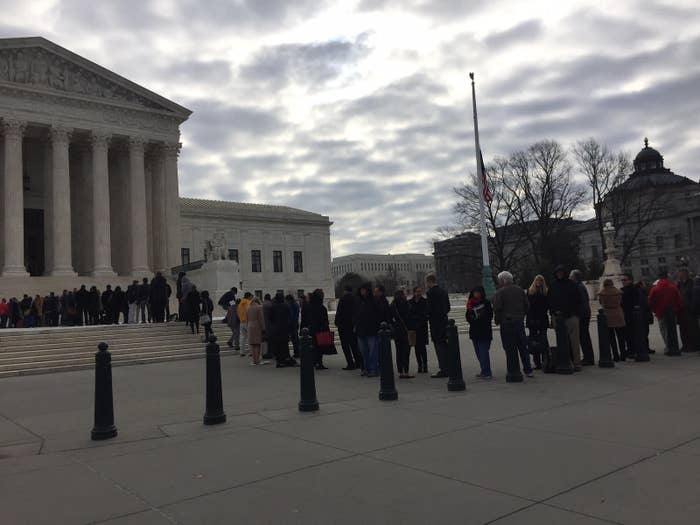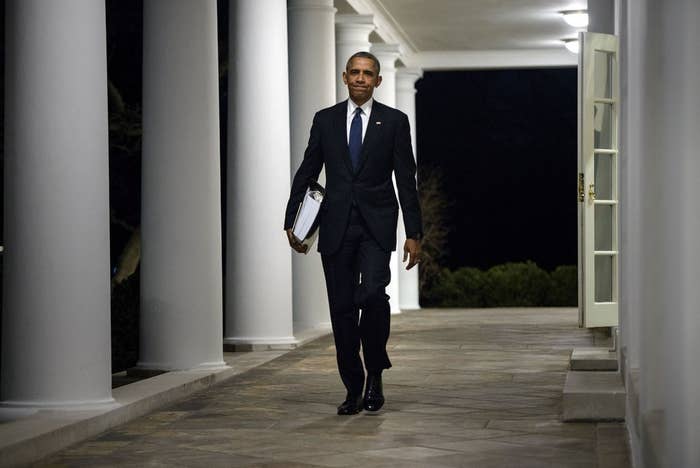
WASHINGTON — On Monday morning, the Supreme Court held arguments for the first time since Justice Antonin Scalia's death. Chief Justice John Roberts marked Scalia's passing in remarks at the start of the day's arguments.
By Tuesday, attention had turned completely to the vacancy on the court. What's actually going to happen in the coming days, weeks, and months?
First of all, BuzzFeed News previously went through what is happening at the Supreme Court without Scalia on the bench and what the main political players had said about what they were going to do about the vacancy. Now, though, the questions have turned to the specifics of what happens with the nomination process itself. So, here goes.
When will Obama nominate someone?
We don't know, but the White House has made it clear that Obama will be doing so with plenty of time for the Senate to do what it would need to do in a confirmation process.
How did it work in the past?
Obama has made two nominations to the Supreme Court. The first appointment came when Justice David Souter announced his retirement from the court during Obama's first year in office, and the second came with Justice John Paul Stevens' retirement.
In Souter's case, the justice had alerted the White House in mid-April of his plans to retire at the end of the court's term in June. Souter formally submitted a letter announcing his intentions to Obama on May 1. Less than a month later, Obama announced his selection of Sonia Sotomayor — then a judge on the 2nd Circuit Court of Appeals — as his nominee on May 26.
In Stevens' case, a 2010 vacancy, the justice announced his intention to retire at the end of the court's term on April 9. Speculation about the potential retirement plans of the justice had been circulating as early as September 2009, when Stevens confirmed that he had only hired one, and not four, clerks to work for him in the term beginning in October 2010. Similar to the Souter retirement, the White House was not caught completely off guard by the retirement. Thirty-one days later, Obama announced his selection of Elena Kagan — then serving as Solicitor General in the Justice Department — as his nominee on May 10.
There was obviously no advance warning this time. In fact, given the timing, it's likely that Obama and the White House had expected that Obama would not be nominating anyone else to the Supreme Court — let alone to replace Scalia.
Nonetheless, the White House has made it clear that they will move quickly — but not too quickly — with spokesperson Eric Schultz saying that Obama "will approach this nomination with the time and rigor required" but also saying that they will do so with plenty of time for "the Senate to consider that nominee."

Is it true that Obama's going to nominate Republican Gov. Brian Sandoval to the Supreme Court?
Well, not so fast.
On Wednesday, the Washington Post reported that Sandoval was being vetted for the nomination.
Here's the thing, though. Based on the Obama White House's actions with the past two nominations, several possible nominees are expected to be vetted by the White House before Obama even speaks to or meets with nominees. With both the Sotomayor and Kagan nominations, Obama met with four different potential nominees in person — after an even larger list had been in consideration — before selecting his nominee.
As such, the Sandoval report is the first of upwards of 10 people who likely will end up being floated as being on the president's "short list" for the nomination. What's more, given that Sandoval is a Republican governor — as opposed to a sitting appellate judge previously considered by Obama for the high court or appointed to an appeals court by Obama or a member of the Obama administration — his vetting would involve more people in more places doing more things. Word of his vetting was more likely to leak anyway.
(Whether Sandoval is in serious contention or just a Republican name thrown into the mix to show Obama is considering a wide range of possibilities is anyone's guess at this point. But when asked if his comments about the vacancy mean he's going to name a moderate, Obama gave a one-word "no" response, followed up with the president asking the reporter how he even got that idea. Based on that, it would appear unlikely that Obama would nominate a Republican to the court.)
In any event, once the "short list" is complete, based on past practice, Obama will pare that list down to four people who he wants to meet with in person. Then, a few days after those in-person interviews, effectively, Obama will call one of them up to offer the person a Supreme Court nomination. The next day, if the person accepts, Obama will announce his selection.
At that point, what happens?
Normally, the Senate Judiciary Committee would take the nomination under consideration and the nominee would receive a questionnaire to complete before the committee schedules hearings for the nominee. During this period, the committee staff are researching the nominee and the nominee is meeting with senators — generally all of the committee members and many others as well.
Then, the hearings are held. After the nominee and witnesses testifying in support of or in opposition to the nominee are done, the committee can ask follow-up questions of the nominee. Then, once everyone is satisfied, the committee would vote on whether to recommend the nomination to the full Senate.
At that point, the Senate majority leader would decide whether and when to schedule the nomination for floor consideration. Once scheduled, debate would ensue, followed by a motion to end debate, a 60-vote majority would end debate, and a vote on the nomination would be held. If the person is approved by a majority of the Senate, the Supreme Court has a new justice.

But, that's not what we are dealing with here, is it?
Nope, not at all.
Majority Leader Mitch McConnell has said repeatedly that the Senate won't consider an Obama nominee. On Tuesday, all of the Republican members of the Senate Judiciary Committee sent a letter to McConnell, saying they won't even hold hearings for the nominee. Several key Senate Republicans have said they won't even meet with the eventual nominee.
Democrats on the committee struck back Tuesday evening, with all of them signing a different letter, calling on the committee to do its work and hold hearings on Obama's eventual nominee. On Wednesday, Obama himself spoke out, making it clear that — in his view — today's hypothetical opposition could play out differently once it turns into actual, long-term opposition to a specific nominee in the midst of a campaign season.
There are signs that everyone isn't totally comfortable with McConnell's plan. The Judiciary Committee's chair, Sen. Charles Grassley, initially had concurred with McConnell, then pulled back, saying he'd wait for Obama to name a nominee before deciding whether to hold hearings. Then, he and his committee sent the letter to McConnell saying he'd hold no hearings regardless of the nominee. Additionally, a White House invitation for Grassley to meet with Obama to discuss the vacancy was not initially accepted. Then, on Wednesday evening, Grassley's office announced that he would, in fact, meet with Obama early next week to discuss the vacancy.
So, what's going to happen?
At the end of the day, and there are likely to be many days in the coming months where the story changes — while not really changing — as political fights play themselves out in the context of Obama's Supreme Court nomination.
To see how different this situation (final-year-in-office vacancy with a Republican-led Senate) is from Obama's first nomination (first-year-in-office vacancy with a Democrat-led Senate), just look at Grassley's earlier reaction to having been contacted then to discuss the vacancy.
From the New York Times in 2009, regarding the Souter vacancy:
As he narrowed his choices, aides said, Mr. Obama kept asking for more original writings by the candidates, and he called every member of the Judiciary Committee, something few if any presidents have done. ...
“He asked if I had any suggestions for nominees,” said Senator Charles E. Grassley, Republican of Iowa, a member of the committee for 29 years. “This is the first time I’ve ever been called by a president on a Supreme Court nomination, be it a Republican or a Democrat.”
Now, the Senate Judiciary Committee's chair — along with the broader Senate leadership and, ultimately, the entire Senate — will need to decide, day by day and week by week, how the politics are playing out and whether they need to meet with the nominee, ask for the nominee to fill out the questionnaire, schedule hearings on the nominee, vote on the nominee in committee, hold a floor debate over the nominee, end debate on the nominee, and vote on the nominee.
Decisions about what kind of nominee the Obama administration will put forward and whether the Senate will take any and each of those steps will play out in the midst of the presidential election and in the midst of elections over 34 Senate seats — 24 of which are held by Republicans.
Whether the court itself is a primarily political body, as some argue, remains up for debate. But the Supreme Court nomination process, already a largely political task, is, in this iteration, entirely a vehicle for politics.
